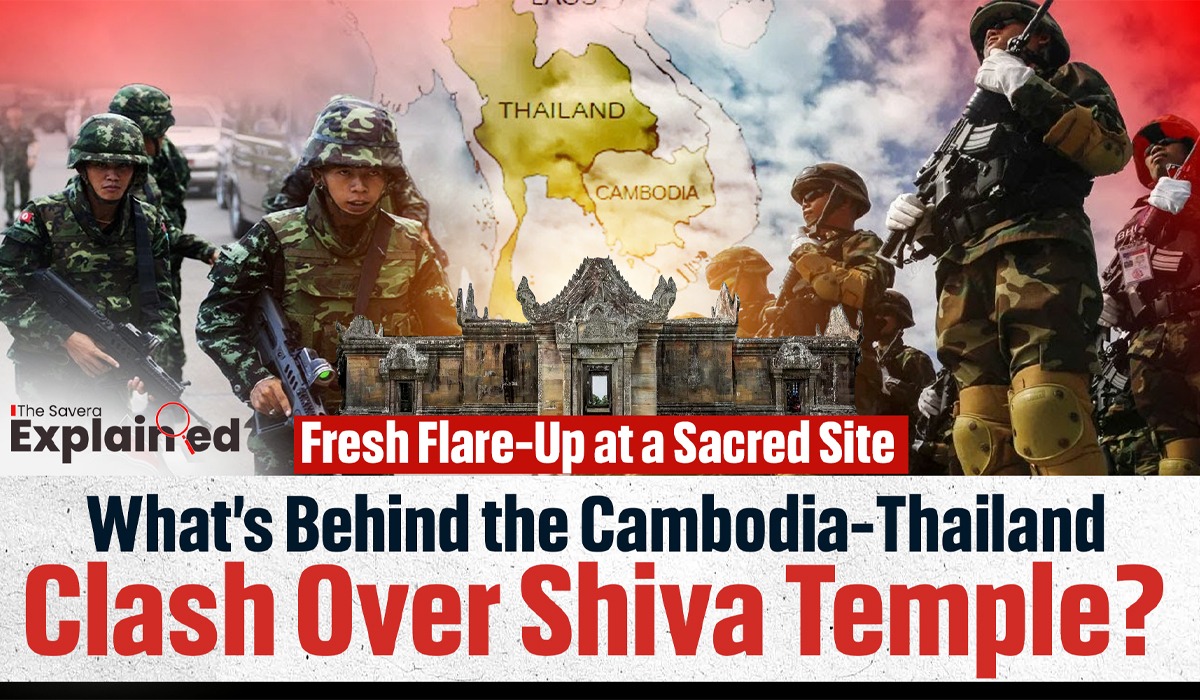Thailand: On July 24, 2025, tensions between Thailand and Cambodia boiled over into deadly clashes near the 11th-century Preah Vihear Temple, a UNESCO World Heritage Site dedicated to Lord Shiva.
The conflict, which claimed at least 12 lives, including a soldier and a child, involved airstrikes and heavy weaponry, marking a significant escalation in a decades-long border dispute.
Both nations claim this ancient Hindu temple, perched on a cliff in the Dângrêk Mountains, as part of their heritage, reigniting a feud rooted in history, nationalism, and geopolitics.
A Temple Caught Between Borders
The Preah Vihear Temple, built by the Khmer Empire between the 9th and 11th centuries, is a masterpiece of Khmer architecture, dedicated to Shiva, the Hindu god. Located atop a 525-meter cliff in Cambodia’s Preah Vihear province, it overlooks the Cambodian plains but is more accessible from Thailand, fueling competing claims.
The temple’s history is tied to the Khmer Empire’s golden age, with kings like Suryavarman I and II enhancing its grandeur. It features intricate carvings, including depictions of Shiva as Nataraja, and later became a Buddhist site as Hinduism waned.
Key Historical Points:
- Colonial Roots: In 1904, Siam (modern Thailand) and French colonial authorities (ruling Cambodia) agreed to draw the border along the Dângrêk Mountains’ watershed line, placing the temple on Thailand’s side. However, a 1907 French map deviated, showing it in Cambodia. Thailand accepted this map but later contested it.
- ICJ Rulings: In 1962, the International Court of Justice (ICJ) ruled 9-3 in Cambodia’s favor, citing Thailand’s long acceptance of the 1907 map. A 2013 ruling reaffirmed Cambodia’s sovereignty over the temple and its promontory, though a 4.6-square-kilometer area nearby remains disputed.
- UNESCO Spark: In 2008, UNESCO’s designation of Preah Vihear as a World Heritage Site triggered protests in Thailand, with nationalists accusing their government of conceding territory. This led to skirmishes from 2008 to 2013.
What Led to the 2025 Escalation?
The latest clashes stem from a mix of historical grievances and recent provocations:
- May 2025 Clash: A Cambodian soldier’s death in a firefight on May 28, 2025, near the temple heightened tensions, with Cambodia accusing Thai troops of crossing into its territory.
- Political Tensions: In Thailand, nationalist groups like the Yellow Shirts have used the dispute to rally support, pressuring the government to take a hardline stance. In Cambodia, the temple symbolizes Khmer pride, making compromise difficult.
- Military Build-Up: Both nations have deployed additional troops and heavy weapons, including Thai airstrikes in July 2025, escalating the conflict. A landmine explosion injuring Thai soldiers further strained relations.
- Failed Diplomacy: Despite ASEAN’s mediation attempts, both countries favor bilateral talks, which have stalled. Cambodia’s plan to file a new ICJ case in 2025 signals ongoing distrust.
Impact of the Conflict
The dispute has far-reaching consequences:
- Human Cost: The July 2025 clashes killed at least 12 people, with earlier conflicts (2008–2013) causing dozens of deaths and displacing nearly 100,000 villagers.
- Economic Fallout: Border closures and trade bans, like Cambodia’s recent halt on Thai imports, disrupt local economies, especially for communities relying on temple tourism.
- Cultural Heritage at Risk: Artillery fire has damaged the temple, with Cambodia reporting a collapsed wing in 2011. Such destruction threatens a shared cultural treasure.
- Regional Tensions: The conflict strains ASEAN unity, raising fears of broader instability in Southeast Asia, especially as both nations militarize the border.
Why It Matters
The Preah Vihear dispute is more than a border skirmish—it’s a clash of national pride, colonial legacies, and modern geopolitics. For Cambodia, the temple embodies its Khmer heritage; for Thailand, it’s a symbol of territorial integrity.
Despite ICJ rulings, the unresolved 4.6-square-kilometer area keeps tensions alive. As both countries dig in, the risk of further violence looms, threatening lives, heritage, and regional stability. Can diplomacy prevail, or will this ancient Shiva temple remain a flashpoint for years to come?

